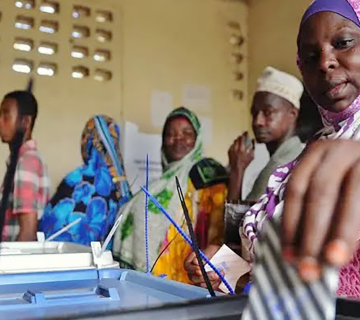If there is one lesson that the world is learning about COVID-19, it is that the virus is averse to laxity; when laxity sets in, some of the gains made to contain the virus are quickly lost. Considering the cost – in life and treasure – that Kenya has already incurred in the five months since the disease was first reported in the country, Kenya cannot afford COVID-19 laxity. Unsurprisingly, Kenyans greeted World Health Organization’s (WHO) observation earlier this month that the country has become “complacent” about COVID-19 with angst. Angst because this assessment amplifies concerns that Kenya could be struggling to come out of its seemingly deepening COVID-19 hole, an array of containment measures notwithstanding. It also speaks to something that some are suspecting – Kenya has begun resigning to her Coronavirus fate when she should be maintaining the intentioned proactivity required to cap the rising number of cases sustainably. There is room, in this realization, for the country to avert her COVID-19 Waterloo. Resetting Kenya’s approach to the ‘global pandemic’ to the proactive mode Kenya had in the period around March 2020 should do the trick.
Off the Rails?
Kenya got a few things right in the period just before and immediately after Kenya confirmed the first case. The government, for instance, set up isolation wards, restricted movement across international borders, stopped non-essential services, and instituted mandatory quarantine and nighttime curfew. However, when the economy begun to show strain, Kenya – torn between saving lives, and securing livelihoods – gradually lapsed restrictions. Some Kenyans (mis)understood this development to mean what could have been done by citizens and the government to contain the disease had been done and threw in the towel. The inclination to give up in the face of unexpected socio-economic pressures such as the ones occasioned by the ‘global pandemic’ is to be expected.
In a report titled Kenya: Phases of the COVID-19 Pandemic Containing the Spread and Reducing the Impact developed by a team of HORN Institute experts, envisaged the resignation phase as one of Kenya’s eight COVID-19 phases (alongside the latent, germinal, incipient, metastatic, emergency, recovery, and reconstruction phases). In terms of caseload, nil cases are reported in the latent phase, while the first known case is confirmed in the germinal phase. In the incipient phase, more cases emerge. Different levels of community transmission are experienced in the metastatic, emergency, and resignation phases. The highest levels are realized in the resignation phase where the health system can no longer cope with the country’s rising caseload. Consequently, and perhaps unconsciously, the survival-of-the-fittest mentality begins to occupy individuals’ psyche. They then begin to wear COVID-19 blindfolds to stop them from seeing more Coronavirus. The recovery and resignation phases follow, and ‘survivors’ begin thinking about reconstructing their pre-COVID-19 realities.
The way authorities manage these phases is a key determiner of the country’s COVID-19 outcomes in the short-, mid-, and long terms. To achieve better COVID-19 outcomes – by which I mean flattening the curve faster with minimal loss of lives and livelihoods, measures instituted to contain the disease must be, according to the said experts, effective, and sustained intentionally and aggressively in the incipient and metastatic phases. Otherwise, the country may appear to be in the resignation phase when it is in effect still in the emergency phase. The emergency phase, according to the report, is characterized by “widespread community transmission, highest number of recorded cases, a strained economy, and anti-government blame games.” This phase demands that both the government and citizens remain proactive to overcome the pandemic.
In recent weeks, Kenyans have generally been working at cross-purposes with the government, with both parties (citizens and government officials) increasingly flouting COVID-19 regulations left, right, and center. The government’s contradictory rhetoric and its selective enforcement of COVID-19 measures have confused and alienated citizens, who have, in turn, disregarded for the regulations, frustrating government. Essentially, “anti-government blame game” has been activated. At the same time, the two parties seem to have made the mental shift into the resignation phase when they need to stay focused on the realities of the emergency phase instead. This has created room for the kind of laxity that could occasion the country’s COVID-19 Waterloo. WHO, keen on continued containment of the virus, has noted this and cautioned Kenya against being “complacent” about the ‘global pandemic.’ It is in Kenya’s interest to heed this warning.
Resetting the Button
Managing the transitions between the emergency and resignation phases of the pandemic, and from resignation to proactivity are tricky affairs. If Kenya gets it wrong, COVID-19 laxity will become commonplace. As it is, Central Bank of Kenya has already revised the country’s pre-COVID-19 economic growth forecast to around three per cent, even as the country’s has confirmed 32,557 cases and 554 deaths (as of August 25, 2020). A good place to start would be a return to the proactive posture that Kenya displayed in the latent and germinal phases. This will require winning the hearts and minds of Kenyans with whom the government must engage to overcome the disease sustainably. This could be done, for instance, by enhanced mass communication campaigns in official and local languages. However, given the “anti-government blame game” that exists, this could be a tall order. Still, the government must demonstrate, in letter and spirit, the high cost that Kenya will bear for being “complacent.” It will also require backing up such communication, and other COVID-19 measures with measured ‘hard’ approaches where necessary. Individuals who flout health guidelines, exposing others needlessly to the disease, and delaying the flattening of the COVID-19 curve, should be reprimanded. This could involve the public issuance of hefty fines, for example. Penalties should be imposed on the spot, with cashless payments being made to a fund managed by a trustworthy custodian that the National Emergency Response Committee on Coronavirus can recommend. The appointed custodian could then channel such funds to enhance anti-COVID-19 work in the country.
Roselyne Omondi is the Associate Director, Research, at the HORN Institute.
Photo: An image showing COVID-19 testing equipment in a laboratory (Photo Credit: ASLM)



